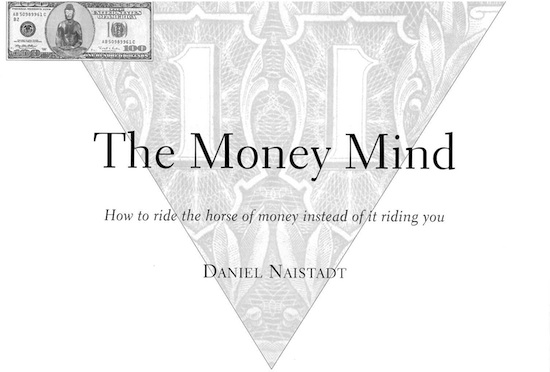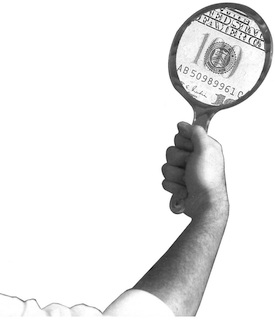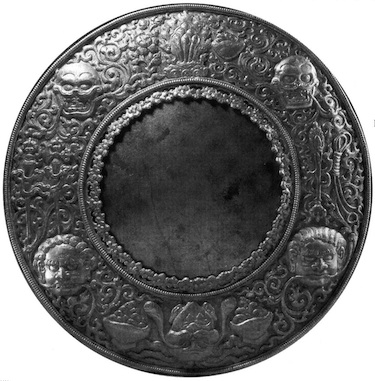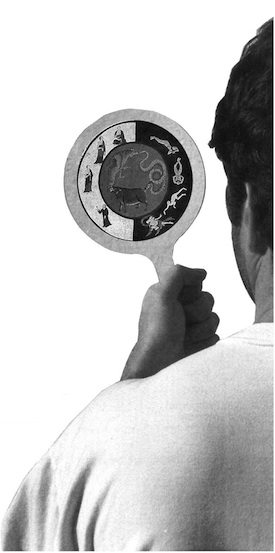
Talking about money can be as taboo as talking about sex. We all tend to maintain a certain secrecy about our relationship with money. We are likely to keep its darkest corners hidden even from ourselves. Nevertheless, money leaves a visible trail. As money flows in and out of our pockets, it follows the many patterns that make up our lives. Whether it’s small change or big paychecks, money mirrors back to us the most intimate knowledge of ourselves and those with whom we interact.
Imagine looking at your home as though through the eyes of an intruder: there is ample evidence of your personal priorities, attitudes and indulgences. Did your money go into books and degrees, clothing and furniture, CDs and sporting equipment? What is the quality and age of your belongings? Are there more pill bottles in the medicine cabinet than cans of food on the shelf? How is your closet arranged? What adorns the walls? What objects represent your values and well-being? What is hidden, what is displayed?

To begin an accurate assessment of ourselves, we need to identify our personal style of working with money: our attitudes, fears, desires, and most importantly, our personal deceptions. There is a certain amount of irony in this process, for despite all the emotional investment we’ve made in our livelihood and finances, we probably don’t have all that accurate a view. The irony is all the greater if we review some of the many different ways in which we apply a “businesslike mindset” to our everyday activities.
As we navigate through our day, we are constantly measuring and calculating. Each meal and snack has an invisible tally of calories and grams of fat. Each chore has a scorecard. This mindset influences our approach to the spiritual path as well. We rank our teachers by their accomplishments. We say that So-and-so spent seventeen years on retreat; So-and-so has established more than twenty practice centers all over the world. Our practice sessions are influenced by a similar mentality. We are forever bargaining with ourselves. We tell ourselves, “If I sit for three hours today, I can skip the next two days.”
The effect of this calculating watcher is a state of mind that is constantly comparing and measuring, thus furthering our sense of separation from the inherent richness of our world, and from spiritual teachings. This results in a mentality of poverty, a sense of incompleteness, inadequacy, and hunger. Buddhist writings describe this psychology as the realm of the hungry ghost, a state where everything that appears in one’s life is regarded as something to be consumed or collected.
The hungry ghost in all of us brings up a question: How much wealth should we possess? But the more important question may be: What constitutes wealth? The late Chogyam Trungpa Rinpoche taught that the logic of wealth is based on one’s presence, on having a good “head and shoulders,” both literally and psychologically. Wealth is expressed through the qualities of basic dignity, confidence, and awareness—the full potential of one’s inherent “worth.” Being “rich” in this sense means projecting an “enriching” presence, which is not a matter of material extravagance but the possession of basic sanity and radiance.
This innate wealth is not something that we manufacture through practice, but rather something that is already present. The goal is to uncover what we already possess. Once this begins to happen, we are able to appreciate and enjoy the richness of the world, without forming the conditional attachments associated with an impoverished, measuring mind.
This principle of inherent wealth provides the basis or “ground” for the journey. Learning to tame and ride our wild horse of money is the essence of the “path.” But in order to successfully join our dharma teachings and practices with our everyday economic life, we need first to overcome the deeply embedded biases and habitual patterns that mark our day-to-day relationship with dollars and cents. Traditionally, Buddhism identifies these root biases as the kleshas, conflicting emotions of pride, jealousy, anger, passion and ignorance.
The Shambhala teachings of Trungpa Rinpoche describe these biases as two poles of emotional energy: fear and hope. Fear is the basic anxiety that creates separation and fixation. Fear keeps us bound to the past, to our cozy, habitual way of doing things. For example, we may have developed a lazy habit of not balancing our checkbook regularly. But at the root of this neglect, there is probably a deeper level of anxiety about what we might see, a fear of looking in the most ordinary mirror of our bank balances. Rather than face the immediate reality of being overdrawn, we postpone the pain until a much uglier situation forces us to pay attention at a later date.
The other pole of emotional energy, hope, is a more subtle force in our lives and is related to our personal desires, ambitions, and attachments. While fear keeps us bound to the past, “hope” seduces us into solidifying our future. For example, people who earn their living in sales positions often end up spending money long before the deal is completed. The slightest prospect of a windfall can cause wild speculations about future possibilities. Whenever we have our resources invested in a situation, even a tiny bit of confirmation can cause a disproportionate response due to our hope for success. We may have just begun a part-time job (one for which we still lack skills), but simply because the situation is new and fresh, our minds leap ahead, and we dream about the benefits of this great new occupation we’ve discovered. How many projects or new jobs have failed to ripen due to these deceptive and paralyzing expectations?
Fear and hope create a series of ruts and ravines in the terrain of our makeup. The effect of these energies on us is such that, even if we are blessed with a downpour of new resources, the fresh rainfall will follow the same old routes embedded in the landscape. Creating a new landscape for our resources, one that is not worn and ravaged by old patterns of fear and hope, requires us to dig deeply into the bedrock of our habitual thoughts and actions. To help accomplish this, we need to draw a detailed map of our personal economic landscape, which is done by reconstructing our financial history.
The initial exercise you should undertake is to evaluate the net worth of your belongings. This is done by first making a list of major possessions and assets—your house and car, or your bicycle and TV set, or your life insurance policy—and determining their value (if you had to sell them). Next, make a list of all of your liabilities: all of your debts and unpaid obligations. After subtracting your debts from the resale value of your possessions, you have a dollar value for your tangible assets. This simple exercise provides us with a realistic, undeniable starting point: we are worth this particular amount of money.
The next exercise is to analyze the flow of your income and expenses over a period of one or several years. This is done by first listing all of your income and then reconstructing where all that money went. This can be accomplished rather quickly by approximating your average monthly expenses, including as many categories as possible, from dry cleaning to housing costs.
After comparing your income with expenses, the final step is to find out if you ended the year with an increased or diminished net worth. First make a list of all the new assets (savings accounts, new car, etc.) that you acquired during that time. Next, make a list of your new debts and obligations. When you subtract these debts from your assets, this shows you how much has been gained or lost during that year.
When we analyze our past financial selves in this degree of detail, we begin to get a multifaceted picture. What sort of patterns of behavior begin to emerge from the numbers? Did we create more debts than savings? What degree of stinginess is revealed? What degree of generosity? How much control did we exercise? Most importantly, were we able to fund the things that mattered most to us?
In order to manage the flow of money in our lives in such a way as to accomplish our goals, we need to create a budget—a plan that can synchronize our best intentions with our available resources. We need to create a hierarchy that harmonizes our vision with our funds.
Trungpa Rinpoche often referred to a set of principles about natural hierarchy, common to many Asian traditions, known as “Heaven, Earth, and Man.” “Heaven” represents our vision, our ideals, and generally all that we hold “above” ourselves. “Earth” represents the practical—the receptive ground that supports and promotes life. “Man” (or humanity) represents the resourcefulness and flexibility that harmonizes the freedom of heaven with the practicality of earth. “Man” also represents the enjoyment that occurs in the environment established by “Heaven” and “Earth.”

When we use these principles as a road map, we can apply them to the task of creating a new budget for ourselves. The “Heaven” of the budget is the most important priorities we’ve selected. First we have to decide on an outlay for our basic needs of food and shelter. As this often requires the lion’s share of our resources, we need to examine what level of comfort and general lifestyle is appropriate to our needs. After deciding on the basics, we realize that while we can’t have everything we want, we may still be able to fund the most important things. For example, we may decide that our long-term goal is to change our employment. This may mean that we allocate enough money for new coursework, and perhaps incur some debts to do this. We might view the practice of generosity and the funding of special causes to be a high, middle or low priority. Planning for a car, a new washing machine, repaying debts, and attending practice retreats are other examples of personal goals. In general, we need to sort through all of our long- and short-term goals and prioritize them accordingly. Having made these selections, we have given ourselves a specific vision, or “Heaven,” that we next need to fund.
The “Earth” aspect of the budget are the disciplines required to balance our expenses and income. The preliminary exercise of reviewing our past spending and earning patterns is the eye-opening groundwork of this process. Once we have a clear view of our financial past and present, we can set up the budget guidelines for who we want to be. These guidelines are the practical tool that puts us in the position of rulership. Armed with a clear view of our resources and a plan for allocating them, we have a saddle and reins to help us gain better control over those events.
The “Man” principle is the aspect of “nowness,” the ability to be flexible, to change in accordance with the situations and coincidences that may occur. “Man” inhabits and enjoys the environment created by “Heaven” and “Earth,” and brings color and life to the landscape.
We may also use these principles to see if our plan has proper balance. If we have too much vision—too many impractical “grand plans”—then we have an overabundance of heaven, and not enough resources to support those plans. If we are too organized—too rigid in our budgeting—then we have too much earth. (If a good sale comes along, we fail to take advantage.) If we’re changing all the time, and never settle down on one basic plan, then we are unable to properly enjoy our resources. There is too much “Man” principle.
Once we have developed a budget that harmonizes these principles of natural order, there remains the difficult task of actually sticking to it. We need to have a personal discipline that works. This discipline is not something that is imposed from outside, but arises from our aspiration; from exercising our freedom of choice. If we have made a viable budget that reflects our long- and short-term goals and priorities, the daily disciplines will arise naturally, as a by-product of our vision.
The most powerful tool that can help us with the multitude of problems that occur in our relationship with money is simple truthfulness. We live in a society where wealth is often garnered by those who have mastered the myriad arts of deception and greed. These patterns of creating wealth are so ingrained in our society that, despite our best intentions to be honest and forthcoming, we suffer nonetheless from this inheritance of lies and quasi-truths. These patterns of behavior are typified by the many thoughtless excuses we offer in defense of inefficiency and poor quality. Phrases such as “It’s in the mail,” “Oh, that’s how it comes,” and “I didn’t notice” all contribute to a subconscious acceptance of a system that produces waste and inferior quality.
Reversing these patterns can occur naturally if we have made it our intent to change all of the expedient, “business as usual” approaches. A personal example: My wife and I have been in the apparel manufacturing business for many years. In the early days, we regarded livelihood largely as a means to an end. We wanted to earn enough money to provide us with the freedom to study and practice, and to be good business partners and employers at the same time. Our products and service were above average, but not consistently so. In the past, when we tacitly agreed to let employees tell small white lies about when goods were shipping late, other employees in turn felt they could “ignore” a small quality problem. As a result of these subtle deceptions, whether personal or collective, the quality of our products suffered.
As we matured in our practice and business, we wished to upgrade our business in order to produce a higher-quality line of clothing. To accomplish this, we had to transform the subtle ways we conducted our everyday business. Employees had to be re-trained and instructed to be inquisitive and forthright. By promoting honesty and heightened awareness, we were able to foster greater cooperation and creativity. This enabled us to execute better designs, so that the quality of our clothing and service improved, as did everyone’s commitment to the company.
 By being honest with ourselves and others, we will begin to transform our relationship with money. However, we will still be operating with ingrained personal views and reactions that can deceptively undermine our progress. When we are engaged in the everyday activities of livelihood and commerce, we receive constant feedback from the world. In the course of any given week, we experience lots of successes and failures in our endeavors. Everyone has experienced runs of good and bad luck, in which it feels as if everything is “going my way” or, just the opposite, “everything is against me.”
By being honest with ourselves and others, we will begin to transform our relationship with money. However, we will still be operating with ingrained personal views and reactions that can deceptively undermine our progress. When we are engaged in the everyday activities of livelihood and commerce, we receive constant feedback from the world. In the course of any given week, we experience lots of successes and failures in our endeavors. Everyone has experienced runs of good and bad luck, in which it feels as if everything is “going my way” or, just the opposite, “everything is against me.”
We can use to this feedback either as a basis for furthering habitual confirmation or as a mirror that reflects back to us our own biased views. This is true for both difficulties and successes. How do we react when things go wrong, such as not getting a promotion, losing our job, or being cheated? Often when we experience such difficulties, we have a fixed knee-jerk reaction: we blame others, we ignore the truth, we deny our own roles in the root causes of these events. Likewise, when we experience positive events, we often heap repeated praise on ourselves, which makes us arrogant and proud.
If we have made it our commitment to get to the root of our habitual patterns, we can use these events as an opportunity to reassess our perceptions and initiate some deeper changes. We can replace our personal “for or against” view with an unbiased meditator’s view. Through the practice of meditation we learn to trust in ourselves unconditionally; we learn to “watch,” without keeping a scorecard. By learning to let go of personal biases, we can understand and acknowledge that money is neither for us nor against us. Money can be seen more simply, as a form of energy that comes and goes. Our path then is to join our meditative practice and insight with our everyday situations, to learn to ride this powerful energy, instead of being ridden by it.
This is not a question of having to manage a large flow of money versus a modest one. The challenge lies in meeting the world with spontaneity; to ride whatever situations we find ourselves in, free from stale views and habits. When we are accomplished riders, balanced and composed, others will begin to notice something—a confidence that translates into an enriching presence. Because on a personal basis, we’ve reversed old patterns of working with money, it is possible to have an influence on others, to create new patterns that circulate wealth for the benefit of society. In the words of Trungpa Rinpoche, we can view money as “mother’s milk”—as an elemental source of nourishment, one that would “dry up” if we tried to hold on to it.